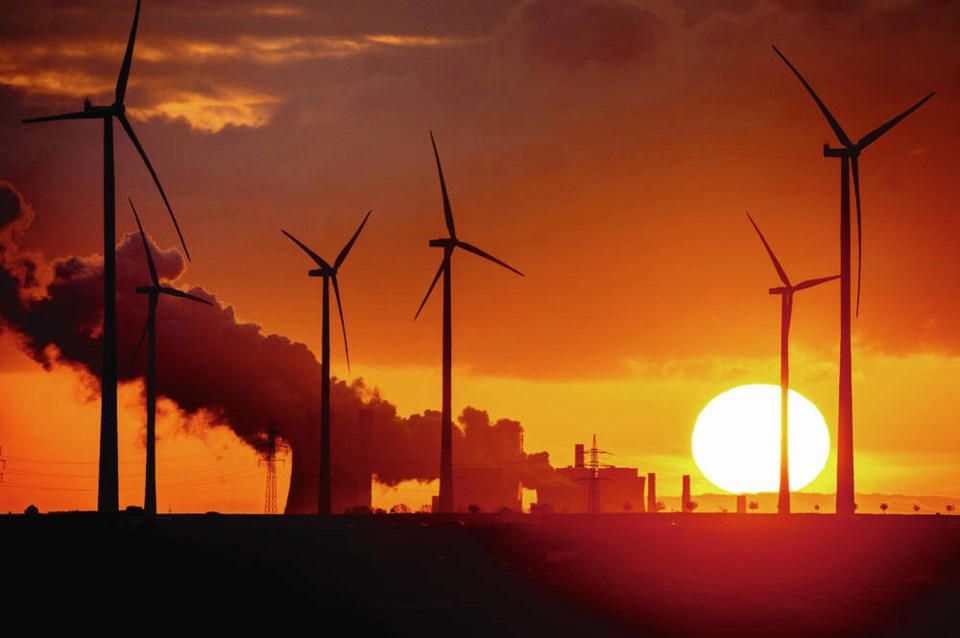Courtesy of the Times Colonist
Photo: Steam rises from a coal-fired power plant in Niederaussem, Germany, this week. With the COP27 UN Climate Summit set to begin in Sharm el-Sheikh, Egypt, on Sunday, Trevor Hancock writes that while CO2 emissions went down a bit during COVID, the three main greenhouse gases — CO2, methane and nitrous oxide — all reached new record highs in 2021. Michael Probst, The Associated Press
One of the five great turnarounds proposed in the recent Earth For All report to the Club of Rome is the energy turnaround. So with COP27 — the annual UN conference on climate change — opening in Egypt, this is a good time to look at this issue.
Regrettably, there is not much in the way of good news, although there is still room for some hope. In a September joint report with other major UN agencies and the U.K. Met Office, the World Meteorological Organization announced that while CO2 emissions went down a bit during COVID, “atmospheric greenhouse gas concentrations continue to rise,” with the three main greenhouse gases — CO2, methane and nitrous oxide — all reaching new record highs in 2021.
The report also noted preliminary data for January to May 2022 show a 1.2 per cent increase in CO2 emissions over pre-pandemic (2019) levels.
This is particularly troubling given that the world is supposed to be working to reduce emissions. Unsurprisingly, current commitments by the nations of the world are not sufficient to meet the goals of the Paris Agreement.
For example, the Lancet Countdown — an annual report on the health impacts of climate change by The Lancet, one of the world’s leading medical journals — reported “the carbon intensity of the global energy system has decreased by less than 1 per cent” in the 30 years since the UN Framework Convention on Climate Change was adopted.
With the current policies and commitments, we will hit betweeen 2.5 and 2.8°C warming by 2100, well beyond the 2°C target, never mind the 1.5°C target. In fact, the report found an almost 50 per cent chance that during the next five years, at least one year will exceed the 1.5°C target. If all national pledges are met — which has not been happening — warming could be kept to 1.9-2.1°C.
The consequences of a mere 1.1°C of warming are already becoming very apparent; the impacts of a rise above 1.5 or even 2°C will be severe. Within the coming decades, in some parts of the world, temperatures could reach dangerous levels at which outdoor labour becomes impossible.
The report notes a five-fold increase in the frequency of weather, climate and water-related disasters in the past 50 years, noting it is costing, on average, $202 million US in losses daily — that’s DAILY!
And as is always the case, “the world’s most vulnerable populations will suffer most, as seen in recent extreme weather events.”
Then there are the health impacts. Released in late October, the Lancet Countdown report proclaimed health is “at the mercy of fossil fuels” and notes “heat-related deaths [among those 65 and older] increased by 68% between 2000 and 2004 and 2017–21.”
Among other things, the countdown reported, “heat exposure led to 470 billion potential labour hours lost globally in 2021” and the potential for the spread of diseases such as malaria and dengue fever was markedly increased, while “every dimension of food security is being affected by climate change.”
The countdown urges a “health-centred response,” which would “reduce the likelihood of the most catastrophic climate change impacts, while improving energy security, creating an opportunity for economic recovery, and offering immediate health benefits.”
Those global health benefits would include preventing many of the 1-2 million annual deaths from fossil-fuel air pollution, while a shift to a more plant-based diet would prevent some 11 million deaths annually.
And what is B.C. doing about this? In short, not much. In late October, a coalition of over 450 B.C. organizations, representing some 2 million people, issued its first report card on B.C.’s progress in addressing 10 urgent climate actions to confront the climate emergency.
Six of the 10 actions received a failing grade, and for two of the four where there was some progress, most of the detailed actions also earned a failing grade.
So here is a challenge for our new B.C. premier, David Eby, as he takes office: Shuck off the legacy of failure bequeathed you by John Horgan and become a true climate champion by adopting a health-centred response to climate action and energy-policy.
Next week, I will discuss what such a policy would look like.
thancock@uvic.ca
Dr. Trevor Hancock is a retired professor and senior scholar at the University of Victoria’s School of Public Health and Social Policy.
